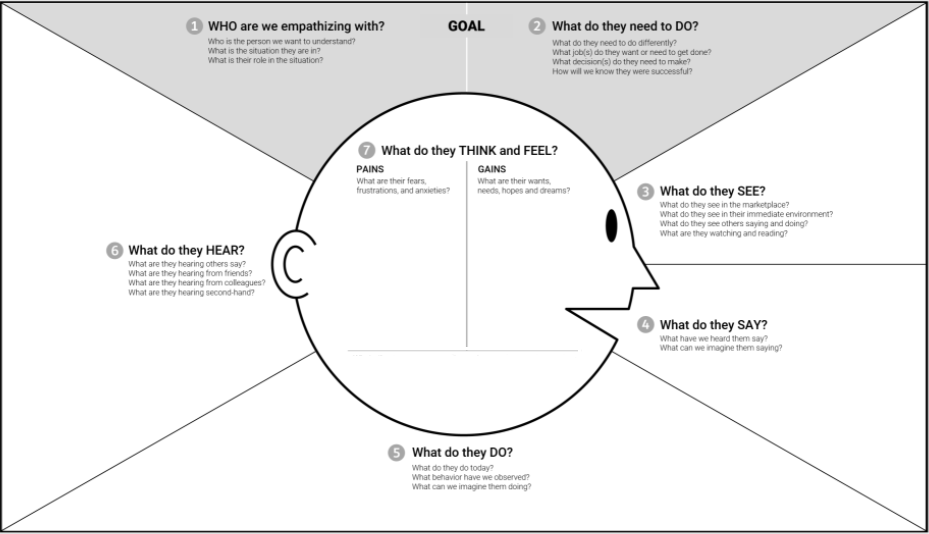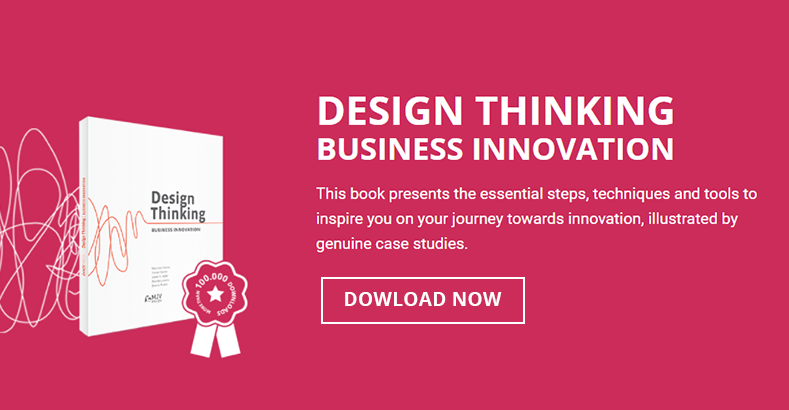Empathy map: what it is and how to use it
Empathy maps help you better understand your customers and provide useful insights.
Empathy is the key to understanding not just how your customers act but who they are.
If we asked you which companies or products you admire or identify with, you’d probably recall experiences that made you feel good, comfortable or fulfilled.
If you’re not a designer or product manager, you may not equate experience with empathy, but the people behind the best products, experiences, and apps certainly do.
Knowing exactly what your customers think, and more importantly, how they feel is crucial not only to developing popular products and services but to empathy as well.
Read on to understand how Empathy Maps can help you create increasingly relevant products and services!
What is an Empathy Map?
An Empathy Map is a visual tool that analyzes and describes behavioral aspects of the ideal customer.
With this simple and didactic resource used by Design Thinking, it is possible to detail the scenario, thoughts, actions, problems, and needs of your target audience.
The more you know about your audience, the more you’ll be able to understand what they need and how to help them fulfill their desires, problems, and expectations.
The protagonist of the Map is always the customer. But the customer is not a single figure. They can be app users, audience members, service consumers. In other words, anyone who relates to what your business offers.
The structure of the Empathy Map is formed by four quadrants that are divided into questions that involve your customer’s interaction with your product or service:
- What does the customer think and feel?
- What do they listen to?
- What do they say and do?
- What do they see?
At the bottom of the map are two more important sections:
- What are their pains?
- What are their needs?

The empathy map is the starting point, which allows you to organize information in a visual way to understand who the customer is.
What problems does the Empathy Map seek to solve?
It’s a challenge for companies to understand their customers. Traditional methods have always tried to understand, quantify, and segment who the target audience is.
When it comes to understanding your customers, details make all the difference. People are not just percentages. They are more than gender, location, age, and profession. They have characteristics in common, and some that set them apart as well.
Putting these characteristics on an Empathy Map humanizes the relationship between company and customer. Seeing your clients through this lens helps companies:
- Understand their customers’ actions;
- Improve communication and promote more relevant content;
- Focus on important issues;
- Better deal with client conflicts;
- Find opportunities to improve products and services;
- Promote more assertive campaigns.
→ Also read: Personas: how this tool can help with consumer analysis
How to create an Empathy Map?
There are several ways to gather rich information about your customers for your Empathy Map.
Market surveys, questionnaires, interviews, in-depth surveys, and social networks are the best way.
The most important thing to keep in mind when filling out an Empathy Map, or when surveying your customers is to ask good questions. These questions will serve as a framework for gathering information.
1. Identify what your audience sees
In this quadrant of the Map, you must identify and understand what your persona observes on a daily basis: where are they inserted, and how do they perceive the world?
Check out these starting questions:
- What is the environment you live in like?
- What sites do you frequent/what kind of content do you consume?
- Which newspapers, magazines, or books do you read?
- What are your friends like?
2. Know what your audience hears
Knowing what your persona hears goes beyond just their auditory senses. Other aspects of their lives can help you understand them as well, like what sort of music they enjoy, or what kind of conversations they have.
Try to find out who influences your audience, and where they get their information from.
Check out these starting questions:
- Who do you look up to?
- Who are your idols?
- What are your favorite brands?
- Who is your favorite content creator?
3. Understand how your audience thinks and feels
This field investigates the persona’s emotional aspect. Try to understand what ideas, thoughts, and sensations come to mind when your customers interact with your products and services.
Check out these starting questions:
- What are your concerns?
- What are your ambitions?
- What state of mind are you normally in when interacting with our products?
- What normally influences your behavior?
4. Find out what your audience says and does
This is where you’ll describe your persona’s behavior. This involves the purchase decision process.
Check out these starting questions:
- What hobbies do you have?
- What are the kinds of things you post on social media?
- How do you communicate with others?
- What subjects are you interested in?
5. Discover what your audience’s pains and needs are
At the bottom of the Empathy Map is where you’ll describe your persona’s pains and needs.
Pain is synonymous with problems, challenges, and difficulties. Needs are what they identify as expectations for your product/service, as well as the goals they are trying to reach throughout their journey.
Check out these starting questions:
- What are you concerned about?
- What causes friction in your day-to-day?
- What problems are you looking to solve?
- What are you trying to get done at the end of the day?
- What do you need to make your dreams a reality?
- What are the steps you need to take to resolve your daily issues?
If some of these questions look like they could serve for locating pains AND needs, that’s because the two are very closely related.
If you’re interested in other Design Thinking tools, then why not download our e-book Design Thinking – Innovation in business and learn about the other ways in which designers mold information into more attractive offers.
Back
